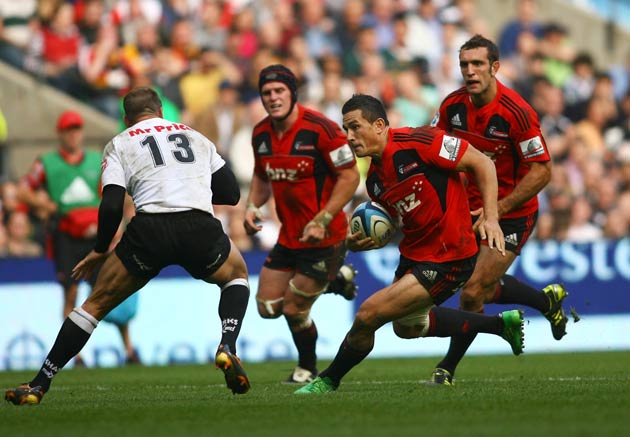Peter Bills: Crusaders performance reminiscent of 1970s France

Your support helps us to tell the story
From reproductive rights to climate change to Big Tech, The Independent is on the ground when the story is developing. Whether it's investigating the financials of Elon Musk's pro-Trump PAC or producing our latest documentary, 'The A Word', which shines a light on the American women fighting for reproductive rights, we know how important it is to parse out the facts from the messaging.
At such a critical moment in US history, we need reporters on the ground. Your donation allows us to keep sending journalists to speak to both sides of the story.
The Independent is trusted by Americans across the entire political spectrum. And unlike many other quality news outlets, we choose not to lock Americans out of our reporting and analysis with paywalls. We believe quality journalism should be available to everyone, paid for by those who can afford it.
Your support makes all the difference.The creative back line skills of the Crusaders in the highly revealing Super 15 game at Twickenham on Sunday were better than almost anything I have seen in world rugby since the French at the start of the 1970s.
The intuitive ball skills, the ability to find space, make the ball do the work and do the basics crisply and efficiently hallmarked this outstanding performance. There have, of course, been some superbly talented threequarters in world rugby over the course of the last 40 years. The British & Irish Lions’ back line of 1971 in New Zealand, for example, was exceptional.
But I can’t remember players from a single country combining to perform so brilliantly in back line play since the French at the start of the 1970s. In that era, they had ball players of genius like Jo Maso and Pierre Villepreux, and they supplemented them with the likes of Jean Trillo, Jean Pierre Lux, Roger Bourgarel, Jean Sillieres and Jean-Louis Berot.
In two successive years against England, 1970 and 1972 at the old Stade Colombes, France produced rugby to make the Gods dance in their heaven. In 1970 in glorious April sunshine, they won 35-13, six tries to two. Just two years later, they improved still further on that, winning 37-12, with six tries to one.
I was there each time and I can tell you, it was the personification of genius and beauty on the rugby field. The French play flowed with the elegance of a Tennyson poem.
The French came close to repeating that sort of stuff in another glorious era, in 1997 and 1998 when they won back to back Grand Slams. Then, coached by Jean-Claude Skrela and the influential Villepreux, they had the mercurial talents of players like Thomas Castaignede, Philippe Bernat-Salles, Stephane Glas and Jean-Luc Sadourny in their back line. Could they play? Well, they put Wales to the slaughter with a 51-0 win at Wembley that clinched the Grand Slam. That was pretty tasty stuff, too.
But what made the Crusaders’ performance last weekend such an epic was that it was achieved under the pressure of the modern game. Go back and watch the tapes, certainly in the 1970s, and you see players revelling in vast amounts of space by comparison with modern times. Opponents were neither as fit nor strong as now and how could they be, for this was the amateur era? Then there was another key factor.
The focus of the game in those days was much more on attack. As the former All Blacks centre Grahame Thorne (1968-1970) told me recently “In our day, you went out to score more tries than the other side. But today, people talk about defence, defence, defence not attack.”
For the Crusaders to have cut to pieces one of the best organised, quickest and potentially strongest defences in Super 15 rugby was a wonder to behold. They did it with a compelling mixture of quick angle changes, clever thinking, deft handling skills and a feel for where the space would be found.
Oh and one other thing – their exquisite off-loading in the tackle that ensured continuity of momentum. In this individual art, Sonny Bill Williams was in a class of his own. Even when collared by some of the Sharks biggest forwards, Williams was able to flick the ball away, either as he fell to the ground or immediately he hit the turf.
All these skills combined to bring the Crusaders four tries in the first 32 minutes, and it determined the outcome of the game. The Sharks were never going to make up a 34-10 deficit against a team as good as the Crusaders.
All the essential requirements for innovative, inventive back line play were there – quick ball, straight running, good decision making, timing of the pass and intelligent thinking. Yet when you went back and re-played the moves, saw them under construction and their exquisite execution, you realised that there was nothing in terms of rocket science.
The Canterbury backs just made the ball do the work so efficiently. They took out opponents with the timing of passes, stepped them to wrong foot defenders and handled with assurance. They weren’t using step ladders to stand 12 feet in the air and hurl 50 metre passes across the field as in American Football.
They just did the simple basics of rugby football highly efficiently and they showed what is still possible in this game if you are good enough and your technique is of true class.
This was a display that ought to have provided enormous food for thought among all northern hemisphere rugby men; yes, even the French too.
Join our commenting forum
Join thought-provoking conversations, follow other Independent readers and see their replies
Comments